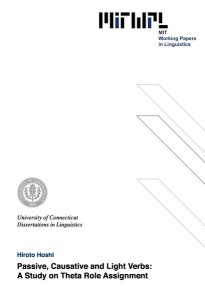Passive, Causative and Light Verbs: A Study on Theta Role Assignment
H. Hoshi, 1994
Abstract
In the enterprise of generative grammar, it has been considered desirable to minimize assumptions and eliminate redundancy.
Following this tradition, Chomsky (1992) proposed that the internal interface levels, D-structure and S-structure, should be eliminated from the grammatical model, because there is no conceptual necessity for them.
In this thesis, I show that to analyze Japanese passives, Romance causatives, and light verb constructions, we must abandon D-structure as a pure representation of GF-θ relations. Thereby, I propose analyses which are compatible with Chomsky’s new grammatical model, and explore their theoretical and empirical consequences.
In chapter 2, I point out that the ni direct passive verb in Japanese has dual characteristics, the combined function of the passive morpheme –en and the verb get of the get passive. To explain these properties, I propose that this passive verb triggers Passivization at the initial point of the derivation, but assigns θ-roles at a later point of the derivation (Hoshi 1994b, cf. Washio 1989-90).
I argue in chapter 3 that like the ni direct passive verb, the Italian causative verb and the Japanese benefactive verb assign θ-roles not at the initial point of the derivation, but later in the course of the derivation. However, as opposed to the ni direct passive verb, the benefactive verb excorporates from the embedded verb for tense feature checking in syntax as does the Italian causative verb (Guasti 1992). Consequently, the proposal suggests that Japanese is an over V-to- I language (Tada 1990, among others).
In chapter 4, I demonstrate that there is an instance in which θ-marking takes place in LF. Based on our previous work (Hoshi and Saito (1993) and Saito and Hoshi (1994)), I propose that in the light verb construction, the nominal θ-marker incorporates to the light verb, and assigns θ-roles at the clausal level in LF.
Table of Contents
INTRODUCTION 1
A CROSS-LINGUISTIC APPROACH TO PASSIVES: ON THE DUAL NATURE OF THE PASSIVE VERB 6
2.1. Introduction 6
2.2. The Nature of the Subject Position 10
2.3. Similarities between Japanese Passives and English Passives 12
2.3.1. Passivization of Verb Phrase Idioms 13
2.3.2. Modification of Subject Oriented Adverbs 14
2.4. Toward a Unified Cross-linguistic Analysis 18
2.4.1. Parallelisms between Ni Direct Passives and Get Passives 18
2.4.2 The Nature of the Empty Category 23
2.5. Proposal: Three Types of Japanese Passives 29
2.5.1. Ni Direct Passives 32
2.5.2. Ni Indirect Passives 38
2.5.3. Ni Yotte Passives 41
2.5.4 Washio (1989-90) 45
2.6. Consequences 51
2.6.1. The Nature of Ni Phrases: Adjunct-ni vs. Argument –ni 52
2.6.2. Binding Domain: Passives vs. Causatives 59
2.7. Conclusions 73
EXCORPORATION AND JAPANESE AS AN OVERT V-TO-I LANGUAGE 75
3.1. Introduction 75
3.2 Similarities between Ni Passives and Romance Causatives 77
3.3. Complex Verb Hypothesis for Romance Causatives 83
3.4. Proposal: an Excorporation Analysis for Romance Causatives 89
3.5. Benefactives: Japanese as an overt V-to-I Language 98
3.6. Conclusions 113
LF THEATA MARKING: THE CASE OF LIGHT VERB CONSTRUCTIONS 115
4.1. Introduction 115
4.2. Argument Transfer 120
4.3. LF Incorporation 125
4.4. Consequences 135
4.4.1 Temporal Constructions 135
4.4.2 VP Preposing 151
4.5 Conclusions 160
Bibliography 162

